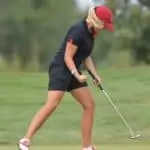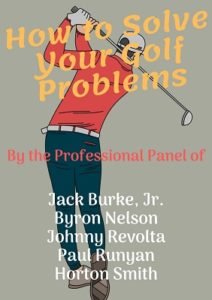As an Amazon Associate, I earn from qualifying purchases. There is no extra cost to you. Thank you if you use our links; we appreciate it! Learn More.
Wondering about how to stop hooking the ball in Golf? You are looking for an answer or a bunch of answers for this, right? Well, the first cure is, if you tend to hit a hook (unintentionally), don’t get disappointed. This is one of the most common issues for golfers, especially in the amateur stage.
A hook is the last fence to overcome on the journey of being a swing expert. A hook says that you are going to be a consistent and good player soon if you can overcome this issue confidently. Here, in this article, we are going to discuss the causes of hooking in golf and how to fix or solve it. Just find out the cause that is creating a hook problem for you, and then you can easily fix that following the solution that comes after the cause.
Before going to the core discussion of how to avoid hooking the golf ball, let’s know something about Golf hooking the ball, in case you do not know about it. If you have enough idea on hooking, just move to the next section.
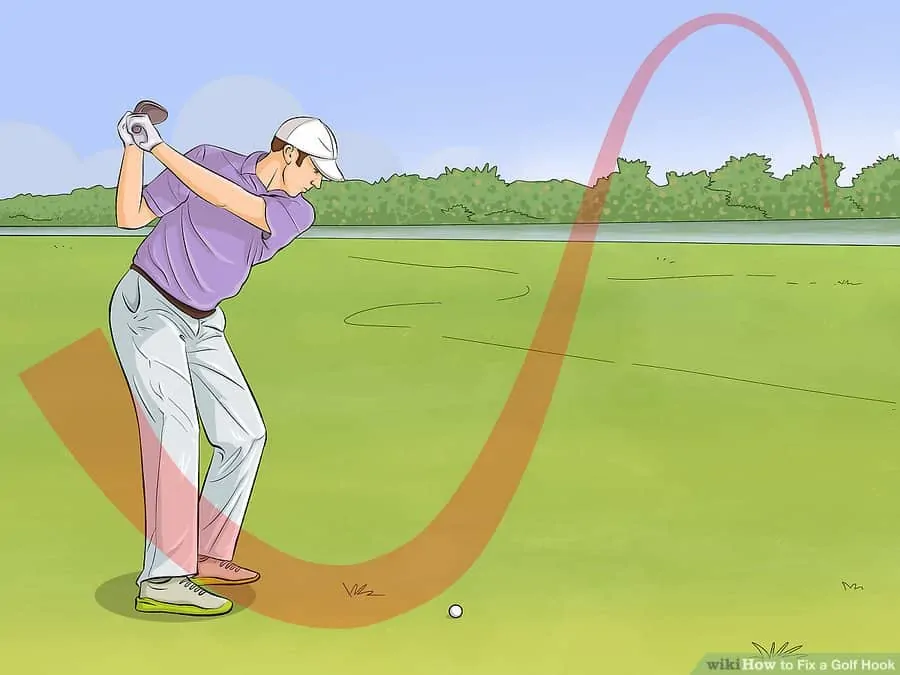
What is Hook in Golf?
In golf, A “hook” or “Golf hook shot” is a kind of shot that happens as a result of major right-to-left curving of the flight of the golf ball (for a right-handed golfer). When it comes to a lefty, it is a hook curve from left-to-right in the golf ball’s flight. A hook can either be intentional or unintentional. But, most of the time it is usually a fruit of a mishit.
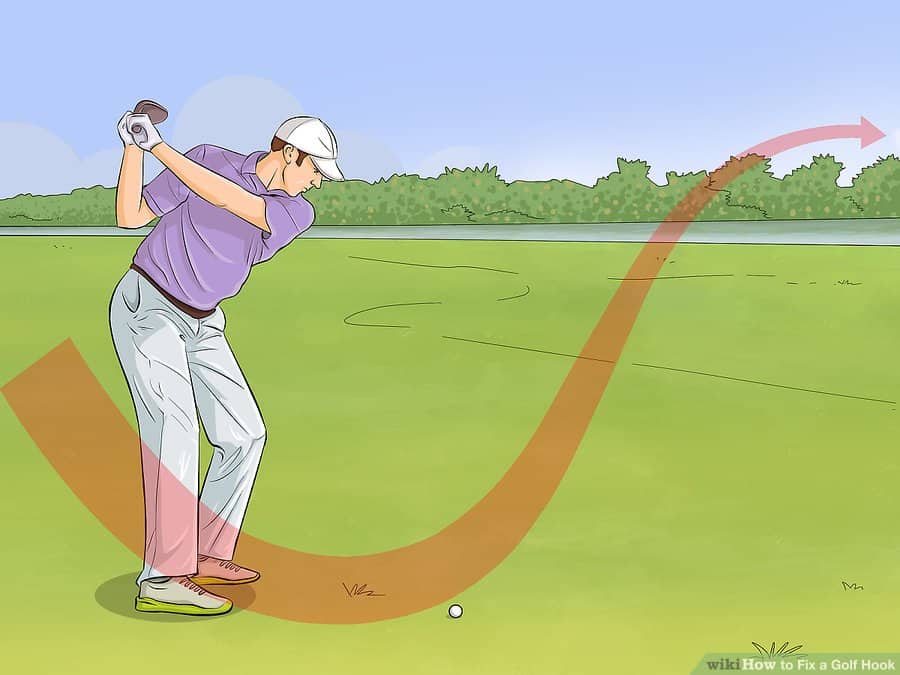
A hook is just the reversal of a slice shot and can be categorized as a severe version of the draw.
Read: Golf hook vs Slice
A “snap hook” or “duck hook” are the terms used for a severe version of a hook.
Well, if you have got some information about the Golf hook definition from here, let’s move to the causes and solution now for which this article is written. Here you will get a clear picture of how to cure a hook in golf.
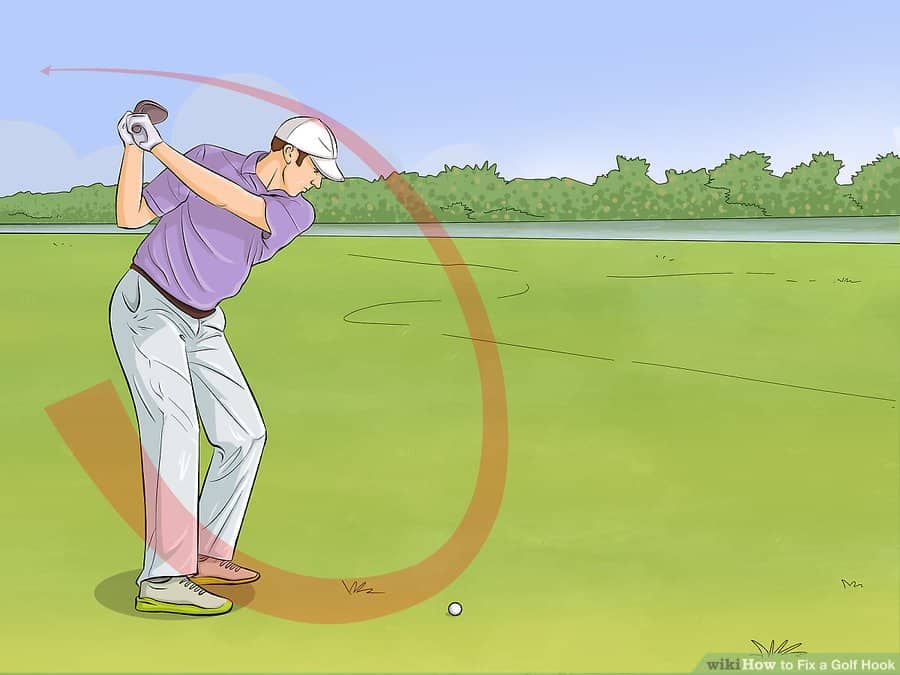
There are several different types of hook shots that a golfer may encounter:
- A severe hook: This is a shot that starts out well to the left of the intended target (for a right-hander) and then curves sharply to the right, often ending up well off the fairway or green.
- A soft hook: This is a shot that starts out slightly to the left of the intended target and then curves gently to the right, landing closer to the intended target than a severe hook.
- A push hook: This is a shot that starts out straight or slightly to the right of the intended target and then curves sharply to the left. This type of hook is often caused by an outside-in swing path or an open clubface at impact.
- A pull hook: This is a shot that starts out straight or slightly to the left of the intended target and then curves sharply to the right. This type of hook is often caused by an inside-out swing path or a closed clubface at impact.
It’s important to note that hook shots can be caused by a variety of factors, including swing path, clubface angle, grip, and ball position. To fix a hook shot, a golfer may need to work on one or more of these elements of their swing.
How to Stop Hooking the Ball in Golf: Causes & Solutions
To fix the hooking in golf you must know “What causes hook in golf” first. Here I will discuss some drills to stop hooking the golf ball according to their cause.
Cause 1: Poor Grip
You may think that a grip is not that important while it comes to the direction swing. You are probably right. But, a grip has a huge contribution to the looks of the clubface at the impact. A grip may not be suitable for everyone. It is because, a grip that might output a smooth and straight shot for player A, might produce a weak shot causing a huge hook for player B.
However, it is possible to make a generalization about the grip when it is related to hooking.
For example, when you stretch your hand too far to the right on your club, it is quite possible that it will return with the clubface that looks at impact to the left.
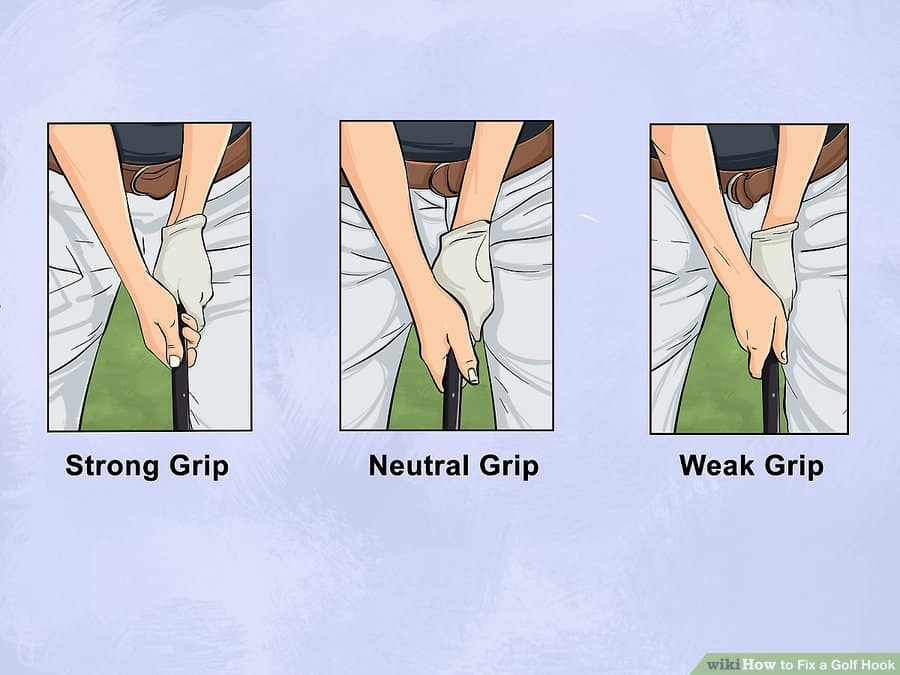
Solution:
While you stand to target the clubface square, firstly, make sure that you are perfectly able to look down. Secondly, when you look down, it is important that you see only two knuckles and not more than this on your left hand. It is because, if three or four knuckles are seen, we can guesstimate that they are responsible for your hooking issue.
Another technique might come to your help. That is, looking at the “V’s” shape that is formed between your thumb and knuckle on both hands. You need to make sure that these are pointing to somewhere near your right ear as well as right shoulder. You should not let them point to left by anyway.
Last but not least, you need to make sure that you have used your right hand to correctly grip the club. You cannot overcome the griping issue unless you put your grip on the club properly. You can watch the VideoJug video named ‘the grip’ to learn about the mystery of making a perfect grip. If you are confused about how to fix a golf hook, and the problem is with poor grip, this will really help.
Cause 2: Wrong Stance or Posture
The wrong golf stance is one of the main factors for hooking. It may sound quite rational that once you understand that you are getting too much to the left, you instantly start doing the opposite to mend the former. Though your action may seem logical, actually it is the worst thing to do.
Because, the fact of the matter is, most of the golfers who hook make this same mistake. Well, what’s the problem here? Actually, if you aim to the right, it will result in the swing’s circle taking the ball too far to the right. This very thing will contribute to intensifying the hooking motion.
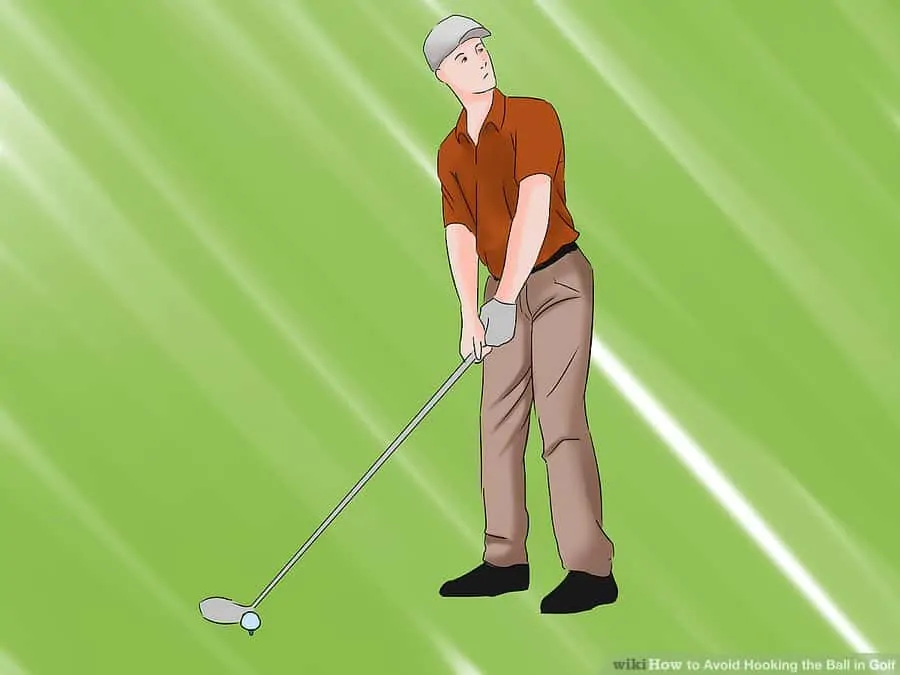
Solution:
Now, you may ask about the solution to the wrong stance issue. At first, you need to double-check the fact that you aim at not too far to the right, especially regarding your shoulders. If you want to check your aim, you should better lay a club on the ground. Place the club in a way so that it remains parallel to your target line.
However, you can also take help from your friend to check that your alignment is right. You need to make sure that your shoulders, knees, hips, and feet– all of these are parallel to the club laid on the ground. This will ensure the fact that you are sticking to your target line as required.
Finally, while you swing, make sure that you have kept your upper body at a certain constant angle comfortable for you. By keeping your weight on the balls while you go for backswing will let you swing the club without any restriction. This is one of the important drills to stop hooking the golf ball.
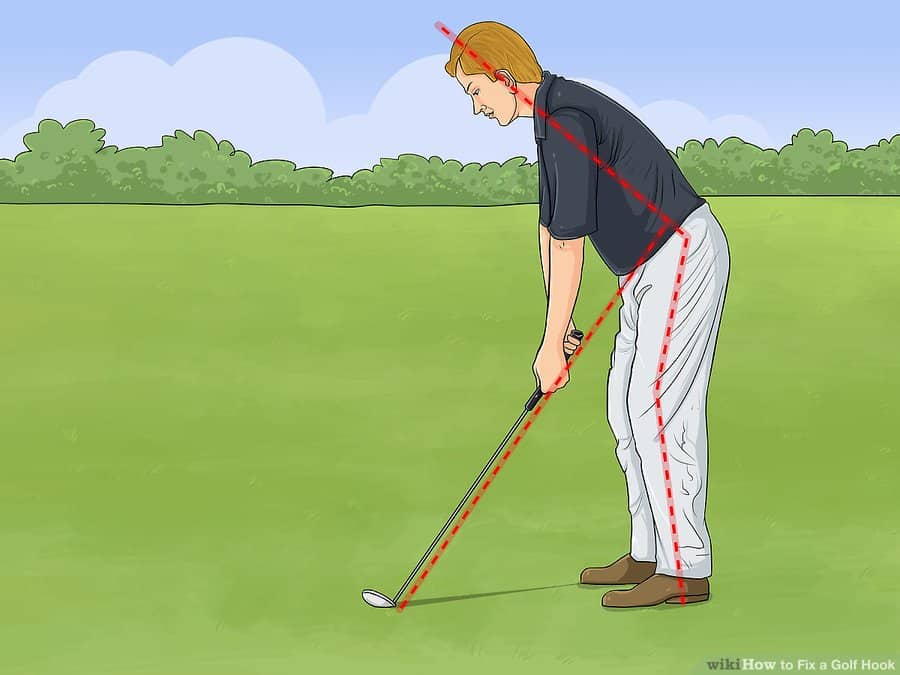
Cause 3: Problem in the Backswing
If your backswing is not appropriate, it may become just another factor that contributes to the hooking problem.
There are several backswing issues that have an adverse effect on your impact. Yet, you can trace two core flaws in the backswing. The first flaw is, going to much inside or around in backswing. The second one is a counter-twist of the shaft. Note that, both can equally be the reason for hooking.
Why are these considered as problems? Well, when your backswing is much inclined to the inside and not up as expected, the club may approach the ball on a certain angle which is extremely shallow or very much on the inside. To put it differently, that can be along the ground more than required. The swing direction produced here will let the ball spin counter-clockwise.

Solution:
To solve the backswing issue, you need to review the backswing that occurs at the top. The shaft should be over your shoulder. Do not let it go much behind your shoulder. When it comes to golf hook fix, this helps a lot.
One mistake is very much common in the backswing. To begin backswing, many of the golfers do the mistake of turning the club counter-clockwise. Unluckily, a closed face at impact is created by that closing of the club.
Read: How to Clean Golf Club Grips, Shafts, Heads & Rust at Home
Another thing is, you should open the clubface on the backswing by relating it to the target line. You can not open that natural opening by a twist in the hands. Rather, you need to turn your torso and shoulders to do that.
While making backstroke you just need to hold on to the club. You should avoid any twisting or hinging of the wrist. To have a proper position, you can look at your left wrist while you try to get to the top. You need to ensure that the back of your left wrist is straight and not otherwise.
Read also: Callaway Strata Review : For beginner to experienced
Cause 4: Issue with Elbow Positioning
If you are a golfer who is okay with everything and yet having a hooking experience, you may have a problem with your elbow positioning. It is a common issue for many golfers that their right elbow sometimes drifts a little bit sideways from the joint when they move the back of the club.
This problem actually shuts the clubface. And ultimately pointing at the ground halfway back, it comes back into impact in a position that is closed. This is one of the big reasons for big hooks!
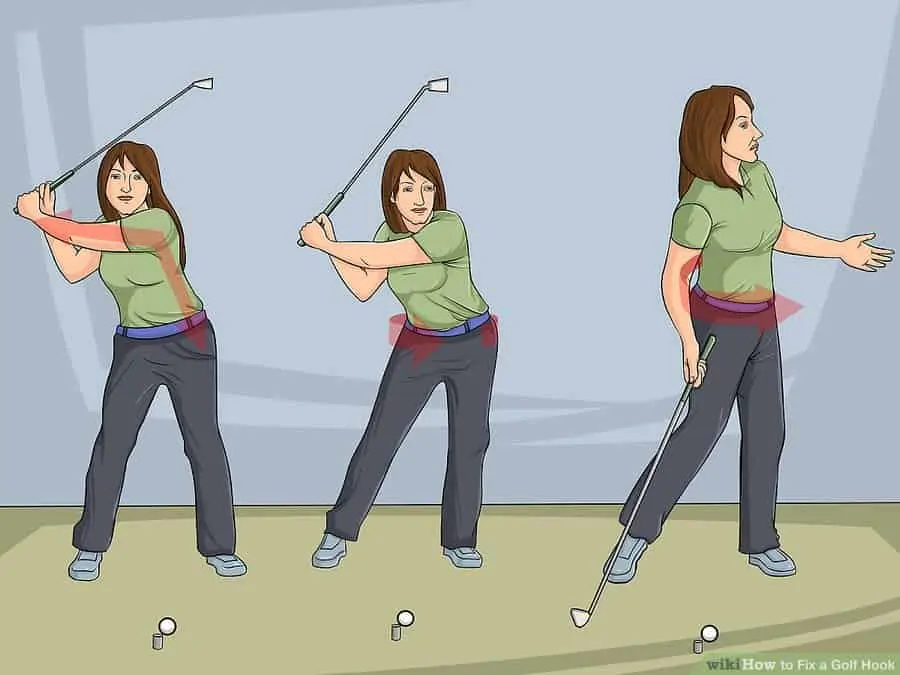
Solution:
To solve this issue, you need to try hard to keep your right elbow a little closer to your right hip as long as you take your club away. This will let you deliver the ball properly-staying in a neutral position.
Cause 5: An Outside-In Swing Path
A hook shot is typically caused by an outside-in swing path, which means the clubhead approaches the ball from the outside of the target line and then swings across the target line towards the inside. This can cause the clubface to be open at impact, which can create a lot of sidespin and cause the ball to curve dramatically to the left (for a right-hander).
An outside-in swing path can be caused by a number of factors, including a poor grip, an overly-wide stance, or an over-the-top swing.
Solution
To fix an outside-in swing path, a golfer may need to work on their grip, stance, or swing mechanics to get the clubhead moving more down the target line.
It’s also worth noting that a hook shot can be caused by an inside-out swing path, which is the opposite of an outside-in swing path. An inside-out swing path occurs when the clubhead approaches the ball from the inside of the target line and then swings across the target line towards the outside. This can cause the clubface to be closed at impact, which can also create a lot of sidespin and cause the ball to curve dramatically to the right (for a right-hander).
Cause 6: Wrong ball position
The ball position in your stance can affect the trajectory, spin, and shape of your shots. In general, a ball position that is too far forward in your stance can cause a hook shot.
When the ball is positioned too far forward in your stance, it can cause you to swing too steeply and approach the ball from the outside of the target line. This can cause the clubface to be open at impact and create sidespin, which can cause the ball to curve dramatically to the left (for a right-hander).
Solution
To fix a hook shot caused by an overly-forward ball position, try moving the ball back in your stance slightly. This will help you approach the ball more from the inside and reduce the chances of an open clubface at impact.
Cause 7: Wrong clubface angle
The clubface angle at impact can have a significant impact on the trajectory, spin, and shape of a golf shot. In general, a clubface that is open at impact (pointing to the left of the target for a right-hander) can cause a hook shot, while a clubface that is closed at impact (pointing to the right of the target for a right-hander) can cause a slice.
An open clubface at impact can cause the ball to spin off the clubface with a lot of sidespin, which can cause the ball to curve dramatically to the left (for a right-hander). This is often the result of an outside-in swing path or a poor grip on the club.
Solution
To fix a hook shot caused by an open clubface at impact, try focusing on closing the clubface at impact. This can be achieved by making sure your grip is neutral and by focusing on swinging more down the target line.
Drills To Stop Hooking The Golf Ball
Here are a few drills that may help you stop hooking the golf ball:
Check your grip
A weak or off-center grip can cause an outside-in swing path, which can lead to a hook shot. To fix this, try placing the club in your hands and pointing your thumbs down the shaft towards the ground. This will help you get a more neutral grip on the club and reduce the chances of an outside-in swing path.
Work on your swing path
To improve your swing path, try setting up a line of tees or alignment sticks on the range and practice swinging along the line. This will help you get a feel for swinging the club more down the target line and reduce the chances of an outside-in swing path.
Practice with a square clubface
A closed clubface at impact can cause a hook shot, so try practicing with a clubface that is square to the target line. This will help you get a feel for how the club should be positioned at impact and reduce the chances of a closed clubface.
Check your ball position
If you’re hitting a hook shot, it’s possible that your ball position is too far forward in your stance. Try moving the ball back in your stance slightly to see if that helps reduce the hook.
Work on your release
If you tend to hang on to the club too long through impact, it can cause an outside-in swing path and lead to a hook shot. Try focusing on releasing the clubhead more quickly through impact to help reduce the hook.
FAQs
How do I stop snap hooking the ball?
To stop snap hooking the first thing you need to consider is your body posture. Other things to consider are your grip and club path. Do not bend too much while doing a swing and keep a good grip in the club. Lastly, practice considering all these and soon you will stop snap hooking the ball.
Why am I hooking my 3 wood?
If you are hooking your 3 wood that means you are struggling and not able to pick the right club. Another reason could be an over-the-top swing. If you keep turning your hands over too soon which means if your right hand rotates the top of your left hand it can hook your 3 woods.
Is it better to hook or slice?
Hook and slice both are shots that can ruin your gameplay in golf thus neither of these shots are good. If you are a beginner in golf you will face both hook and slice in your shots. Hook and slice happen for wrong body posture and swings. If one keeps practicing and focuses on his/her body posture and swings, he can easily ignore both hook and slice in golf.
Final Checklist of How to Cure a Hook in Golf
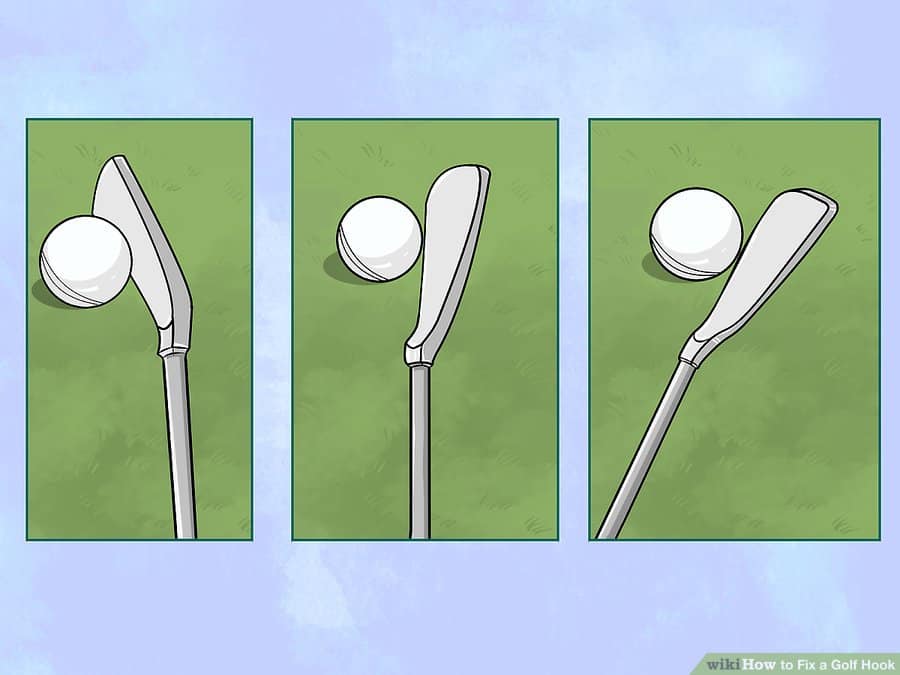
Avoiding hook is easy if you can find out the culprit that is responsible for hooking. And finally, to summarize how to stop hooking the ball in golf, we would suggest you to use this checklist to avoid hooks:
- Hips, shoulders, and feet are according to the proper alignment and parallel to the target line.
- Clubface in the right square position.
- Hand in neutral grip position.
- If you can see two knuckles in your left hand as required.
- Turning left toe out.
- The lower half is not inactive.
See also:
- How to fix Golf Shank
- Best Golf Forums
- How to Putt in Golf
- New Golf Rules 2019
- Rules of Golf Etiquette
- Stretching Exercise Before Golf
- Best Gift for golfers
- How to hold a golf club Properly
- How to hit a Flop Shot
- Sunglass Tint color Guide
- Amazon Prime Day
Amazon and the Amazon logo are trademarks of Amazon.com, Inc, or its affiliates.
Daisy is the Founder and Editor in Chief of Golfs Hub. She is associated with Golf for more than 20 years. She got the inspiration from her father. She is a very private person & doesn't like to be photographed. She's worked in nearly every job in the golf industry from club fitting to instruction to writing and speaking. Now she is enjoying her retirement from day job... but not from Golf! Daisy lives in southeasternmost part of New York state with her family.
